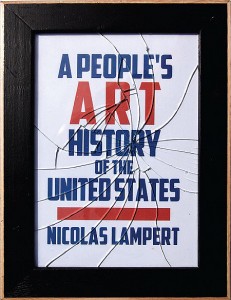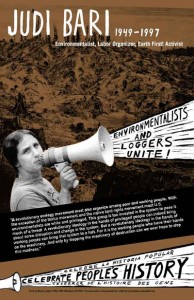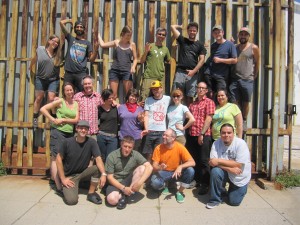A few weeks ago I had the privilege of interviewing Nicolas Lampert,
a long-time artist and activist working out of the University of
Wisconsin–Milwaukee. Lampert was an early member of the Justseeds Artists
Cooperative — a printmaking collective — and the author of the
recent book, A People’s Art History of the United States
(which I reviewed a while
back.) We talked about the genesis of Justseeds, working with
Howard Zinn, and what we can learn from history about the challenges and
potential of harnessing the arts to social justice movements.
 I was hoping you
could start by telling me a little bit about your background, and how
you ended up working in the area of art and social movements.
I was hoping you
could start by telling me a little bit about your background, and how
you ended up working in the area of art and social movements.
My art has been aligned with activism since the early 1990s when I moved from Michigan to Oakland, California in my early twenties. My time in the Bay Area was an awakening period for me. It awakened me to so many activist campaigns and issues. It was a point of no going back. Once I learned about all these issues and saw the power of movement culture it seemed natural to direct my visual art to the causes I believed in.
When I talk to a lot of cultural organizers and arts activists, a common theme is the struggle to combine arts and social justice work since, especially in this country, the two can feel very separate. What was the process like trying to bring together your visual arts work with activism?
Well, you’re right, art and social justice work are often presented as polar opposites. I grew up outside of Boston, and was never introduced to the idea that the two could merge. This might have been because I was not looking in the right places, but I certainly was not introduced to the idea of activist art in high school or college for that matter. I went through a fairly conventional art training that focused its attention toward the art world – the gallery and the museum as the only important places where art happened. The type of art that I wrote about in A People’s Art History was all but absent from my education. When it was presented it was often presented as significant politics, but art that was subpar and far below the quality of art found in the “art world.”

I needed to go through a period of un-training myself. My education took a jump simply by living in the Bay Area. I was exposed to groups like Food Not Bombs, Cop Watch, spaces like the Long Haul, projects like Free Radio Berkeley, and hearing talks from people like Judi Bari. For three or four years I was just a sponge for all the activism in the Bay Area. I became disenfranchised from the “art world” and the type of art that had inspired me in the past. I became much more interested in underground music and began to really question if visual art would continue to be my focal point or not. Luckily, I was introduced to art that spoke to my concerns and the movements that I was participating in. I became more aware of the artists who produced World War III Illustrated. I started seeing the graphic work of John Yates pasted around the Bay Area and on album covers in the punk scene. This inspired me to put up my own images in the street and to merge more of my art with my politics.
My own work was still developing but I had a supportive community around me. I lived in a warehouse space that had shows every weekend — touring bands, film showings, art shows. We were around a host of really interesting people that were all becoming politicized and have gone on to do some really interesting work, people like Trevor Paglen and A.C. Thompson, people who were living out their politics on a daily basis. The bookend for that period for me was the WTO protests in Seattle — spending a week immersed in that, seeing the power of direct action and seeing the art that happened up there, like the work that David Solnit and others were doing in Art and Revolution.
Two years after Seattle I co-organized with Sue Simensky Bietila a traveling political art show called Drawing Resistance. It included 30-plus artists and traveled from city to city across North America for nearly a half decade. The model was based off a D.I.Y. punk-rock tour and building an underground network. The show began in Milwaukee and Sue and I then transported it to Chicago. The Chicago hosts then had autonomy to choose their own location for their show and have a local art component to accompany the traveling show. However, they had to then transport the artwork to the next city — Detroit. And then the Detroit hosts had to get the show to the next city down the road. This built an incredibly infrastructure and network, and that’s where I started to meet many of the artists that would become part of Justseeds.

How did Justseeds come about?
It came about through mutual friendships and mutual respect for each other’s work. Josh MacPhee first started Justseeds in the late 1990s as a way to distribute radical art through the mail. He was distributing his own work, plus the Celebrate People’s History project that he still curates to this day. At the same time, he began reaching out to other artists whose work he admired and began distributing their work as well. After a while, Josh reached out to the folks in Clamor magazine who expanded the reach of his distro, but when Clamor went under, their assets and stock was seized and Josh found himself in major debt, with no way to distribute his work. So he reached out to 10 or 15 of his friends and said, “You know, I’ve been thinking about this for a long time, and I want to turn Justseeds into a collective.” We launched Justseeds and it just amplified all of our practices. We now have 30 artists in Justseeds and are going on close to 10 years as a worker-run print cooperative.
Let’s turn to your book. What inspired you to write A People’s Art History of the United States?
I was directly inspired by Howard Zinn. I wouldn’t have written the book without his influence or direct guidance. I had read his book – A Peoples History of the United States — and was really surprised about how much I didn’t know, especially about the early labor movement. It really rekindled my interest in history and my interest in scholarship as a form of activism.
When I first started teaching at the college level in Milwaukee I wrote to him. I knew that he would speak in Madison a couple times a year, and I asked him if on one of his trips if he’d visit my classroom. He wrote back and said, “I’d love to, and I’ll be in town in a couple of months.” He noted that for it to work, I would have to pick him up in Madison and drive him to Milwaukee, which was pretty much too good to be true.
So a few weeks later I found myself driving down I-94 with Howard Zinn in the passenger seat en route towards my classroom. And during the whole ride he didn’t want to talk about himself. He wanted to know about what was going on in Milwaukee, about my interests, and about my teaching. So I talked to him about radical art, and the role of art in the anti-war movement, and by the end of that ride he basically said, “I initiated the People’s History series through The New Press and we are lacking a book on visual art. If your interested, send me a one page proposal for A People’s Art History and if I like your proposal I’ll put you in contact with my editor at The New Press.” This invitation propelled me on an eight-year project to research and write the book. Howard Zinn wasn’t my editor, but from time to time I would send him drafts, or send him emails, or call him up on the phone. It was inspiring, to say the least, to get feedback from Howard Zinn.
Click HERE to read Part 2 of my interview with Nicolas Lampert

